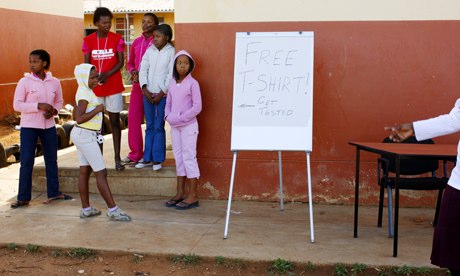
Millions of young people are at risk of HIV infection because governments are not providing appropriate health services, according to the World Health Organisation (WHO).
The failure to adequately support 10- to 19-year-olds has resulted in a 50% increase in reported Aids-related deaths among this age group between 2005 and 2012, bucking the global trend among the general population that saw deaths fall by 30%. Most of the new infections occur in young women, who are up to three times more likely to get infected than young men – due in part to their lower social status in some countries.
The WHO said the increase was largely down to the failure of governments to prioritise adolescents in national HIV plans or provide teen-friendly testing services and counselling.
Another, more specific, reason for the high number of deaths is because many young people who were born HIV-positive either did not receive antiretroviral treatment straight away, or, if they did, failed to receive adequate follow-up care but managed to survive into adolescence.
In the runup to World Aids Day on 1 December, the WHO on Monday issued new guidelines on HIV support and care for adolescents, which call for more tailored approaches to testing and counselling and better, more immediate, access to treatment if young people test positive. Young people also need more support to disclose their status to their families and to stick to treatment regimes, the organisation said.
It added that not enough attention had been given to research on how best to tackle the disease among this cohort and the sorts of programmes that would work best for them.
"Adolescents face difficult and often confusing emotional and social pressures as they grow from children into adults," said Dr Gottfried Hirnschall, director of the WHO's HIV and Aids department. "Adolescents need health services and support, tailored to their needs. They are less likely than adults to be tested for HIV, and often need more support than adults to help them maintain care and to stick to treatment."
Data collected from sub-Saharan Africa shows that only 10% of young men and 15% of young women between the ages of 15 and 24 were aware of their HIV status.
"Adolescent girls, young men who have sex with men, those who inject drugs or are subject to sexual coercion and abuse are at highest risk," said Craig McClure, chief of HIV programmes for the UN children's agency, Unicef. "They face many barriers, including harsh laws, inequalities, stigma and discrimination, which prevent them from accessing services that could test, prevent and treat HIV. About one-seventh of all new HIV infections occur during adolescence. Unless the barriers are removed, the dream of an Aids-free generation will never be realised."
Unicef is using television, radio, mobile phones and social media to disseminate information about HIV to young people in six African countries, and to link them to services.
The agency found that while there was a good level of knowledge on the benefits of using a condom, there was still a reluctance on the part of young people to ask partners to be tested. They did not want such a request to infer their partner had been unfaithful or had a promiscuous past. Young men were also less likely to seek testing or services than women. Many young people also avoid seeking services because the consent of a parent or guardian was required.
On Tuesday, the University of Oxford reported the results of a study in South Africa that found giving grants to teenage girls significantly reduced their risk of HIV as they were less likely to acquire a "sugar daddy" – an older man who pays for school fees or food in return for sex.
The three-year study involving more than 3,500 teenagers, found that girls from households receiving government child support grants were two-thirds less likely to take older partners and half as likely to have sex in exchange for food or fees.
Researchers said government grants reach about 70% of eligible children, but if expanded had the potential to prevent 77,000 teenage girls from starting relationships with older men, which could cut HIV infection rates.
Similar cash transfer schemes in Malawi had lowered HIV prevalence. More than 40% of new infections in the country are among adolescents.
The advocacy group ONE on Tuesday called for the launch of a "prevention revolution", particularly among young people and marginalised groups, to accelerate the global fight against HIV and Aids.
ONE said 16 countries in sub-Saharan Africa had reached the tipping point on infection rates – where the number of new HIV infections is lower than the number of patients receiving treatment in the same year. But progress across the continent is patchy, and more funding and greater political will were needed to bring about change.
According to ONE, donor funding for HIV and Aids has stalled and the majority of African governments are not meeting their commitments to spend 15% of their budgets on health.
Next week, the Global Fund to Fight Aids, Tuberculosis and Malaria will be holding its pledging conference in Washington. The fund says it needs $15bn (£9.3bn) in replenishment money between 2014 and 2016. This month, Mark Dybul, the fund's executive director, told its board he was highly confident the pledges made at the conference would significantly exceed the $9.2bn pledged at the third replenishment round in 2010.

